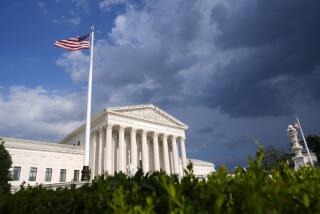Pay for Federal Judges Must Be Increased, Rehnquist Says
WASHINGTON — Supreme Court Chief Justice William H. Rehnquist and leaders of two of the nation’s largest lawyers’ associations joined Tuesday in pushing for higher salaries for federal judges.
Rehnquist appeared with the presidents of the American Bar Assn. and the Federal Bar Assn., who presented a report warning that salary levels on the federal bench “have reached such levels of inadequacy that they threaten to impair the quality and independence” of the judiciary.
“I consider the need to increase judicial salaries to be the most pressing issue facing the federal judiciary today,” Rehnquist said in a brief appearance at a Supreme Court news conference. “We must provide these judges--whom we ask and expect to remain for life--adequate compensation.”
The average district court judge makes $145,000 a year, compared with salaries for partners at major law firms that can exceed $500,000 annually, the report said. Some first-year associates in major cities earn an average $125,000 a year, the report said.
“Lawyers straight out of law school make more at the top firms than federal judges with 30 years’ experience,” said FBA President Robert McNew. “That’s why we are beginning to see greater numbers of judges leaving the bench and some promising candidates not willing to serve.”
Although federal judges have received recent cost-of-living raises--2.7% last month and 3.4% in 2000--they had not received one before that since 1993.
Declining salaries are the “single most important factor discouraging potential candidates from seeking judicial appointment,” the report said.
“What cost are you willing to put your family through to engage in public service?” asked ABA President Martha Barnett. “There is a real financial disincentive there.”
In the last decade, 52 circuit and district judges left positions that were tenured for life--more than during any other period in the nation’s history, the report said.
Two such judges who left the bench because of salary concerns--Layn Phillips and John Wagner--both served in the 10th Circuit Court in Oklahoma but now work at Irell & Manella, a Los Angeles-based private law firm.
“We needed to educate our children, and it got harder and harder to do that on the salary I was being paid,” said Wagner, who left the bench three years ago and works at the firm’s Newport Beach office. “I needed to make multiples” of what he was making as a judge, he said.
Despite the prestige of a federal judgeship, failure to increase salaries could lead to a bench made up largely of those who do not need to earn a living, the report warns.
“If we continue to allow the pay of federal judges to lag so far behind both inflation and the spiraling compensation of attorneys in private practice,” Rehnquist said, “we risk ending up with a judiciary made up primarily of the wealthy.”
McNew agreed. “We should reward our judicial candidates [based] on wisdom, not wealth.”
Federal judicial pay levels are linked to the salaries of Congress and high-level employees of the executive branch--a link, the report suggests, that is no longer justified.
The report recommended a 9.6% pay raise for federal judges, which would mean increases ranging from $14,000 to $18,000 a year, depending on the court level. The study also suggested that the requirement that Congress approve any federal judicial pay increase should be repealed to allow a pay-raise mechanism enacted in 1989 to operate.
That 1989 measure, part of the Ethics Reform Act, recommended automatic annual salary increases for judges. If those increases had been carried out, the annual salary for federal judges would now stand at $159,300.
Rep. Judy Biggert (R-Ill.) introduced legislation Tuesday seeking a 9.6% pay increase and requiring annual cost-of-living increases.
The ABA, the nation’s largest lawyers’ organization, has more than 400,000 members. The FBA, with 15,000 members, is made up of lawyers who practice before federal courts and administrative agencies.
More to Read
Sign up for Essential California
The most important California stories and recommendations in your inbox every morning.
You may occasionally receive promotional content from the Los Angeles Times.










